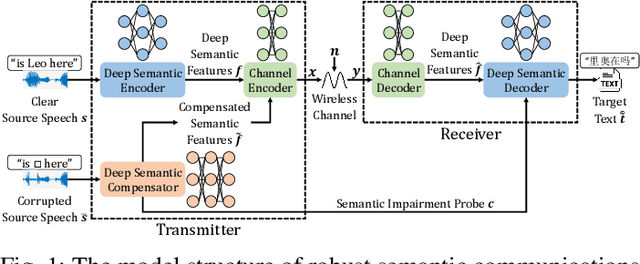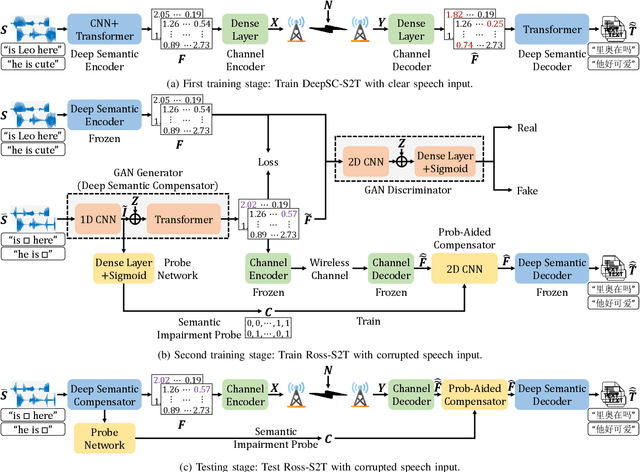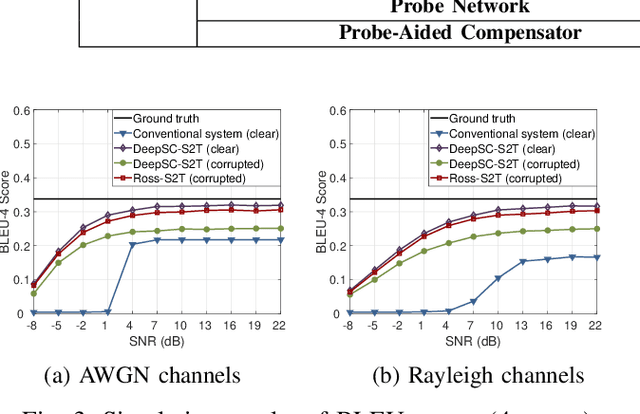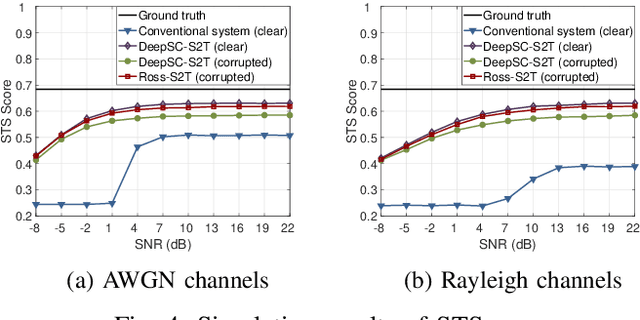Xiaoming Tao
Few-shot Semantic Encoding and Decoding for Video Surveillance
May 12, 2025Abstract:With the continuous increase in the number and resolution of video surveillance cameras, the burden of transmitting and storing surveillance video is growing. Traditional communication methods based on Shannon's theory are facing optimization bottlenecks. Semantic communication, as an emerging communication method, is expected to break through this bottleneck and reduce the storage and transmission consumption of video. Existing semantic decoding methods often require many samples to train the neural network for each scene, which is time-consuming and labor-intensive. In this study, a semantic encoding and decoding method for surveillance video is proposed. First, the sketch was extracted as semantic information, and a sketch compression method was proposed to reduce the bit rate of semantic information. Then, an image translation network was proposed to translate the sketch into a video frame with a reference frame. Finally, a few-shot sketch decoding network was proposed to reconstruct video from sketch. Experimental results showed that the proposed method achieved significantly better video reconstruction performance than baseline methods. The sketch compression method could effectively reduce the storage and transmission consumption of semantic information with little compromise on video quality. The proposed method provides a novel semantic encoding and decoding method that only needs a few training samples for each surveillance scene, thus improving the practicality of the semantic communication system.
Multi-Task Semantic Communications via Large Models
Mar 28, 2025Abstract:Artificial intelligence (AI) promises to revolutionize the design, optimization and management of next-generation communication systems. In this article, we explore the integration of large AI models (LAMs) into semantic communications (SemCom) by leveraging their multi-modal data processing and generation capabilities. Although LAMs bring unprecedented abilities to extract semantics from raw data, this integration entails multifaceted challenges including high resource demands, model complexity, and the need for adaptability across diverse modalities and tasks. To overcome these challenges, we propose a LAM-based multi-task SemCom (MTSC) architecture, which includes an adaptive model compression strategy and a federated split fine-tuning approach to facilitate the efficient deployment of LAM-based semantic models in resource-limited networks. Furthermore, a retrieval-augmented generation scheme is implemented to synthesize the most recent local and global knowledge bases to enhance the accuracy of semantic extraction and content generation, thereby improving the inference performance. Finally, simulation results demonstrate the efficacy of the proposed LAM-based MTSC architecture, highlighting the performance enhancements across various downstream tasks under varying channel conditions.
Corrections to "Computer Vision Aided mmWave Beam Alignment in V2X Communications"
Oct 08, 2024



Abstract:In this document, we revise the results of [1] based on more reasonable assumptions regarding data shuffling and parameter setup of deep neural networks (DNNs). Thus, the simulation results can now more reasonably demonstrate the performance of both the proposed and compared beam alignment methods. We revise the simulation steps and make moderate modifications to the design of the vehicle distribution feature (VDF) for the proposed vision based beam alignment when the MS location is available (VBALA). Specifically, we replace the 2D grids of the VDF with 3D grids and utilize the vehicle locations to expand the dimensions of the VDF. Then, we revise the simulation results of Fig. 11, Fig. 12, Fig. 13, Fig. 14, and Fig. 15 in [1] to reaffirm the validity of the conclusions.
Synchronous Multi-modal Semantic CommunicationSystem with Packet-level Coding
Aug 08, 2024



Abstract:Although the semantic communication with joint semantic-channel coding design has shown promising performance in transmitting data of different modalities over physical layer channels, the synchronization and packet-level forward error correction of multimodal semantics have not been well studied. Due to the independent design of semantic encoders, synchronizing multimodal features in both the semantic and time domains is a challenging problem. In this paper, we take the facial video and speech transmission as an example and propose a Synchronous Multimodal Semantic Communication System (SyncSC) with Packet-Level Coding. To achieve semantic and time synchronization, 3D Morphable Mode (3DMM) coefficients and text are transmitted as semantics, and we propose a semantic codec that achieves similar quality of reconstruction and synchronization with lower bandwidth, compared to traditional methods. To protect semantic packets under the erasure channel, we propose a packet-Level Forward Error Correction (FEC) method, called PacSC, that maintains a certain visual quality performance even at high packet loss rates. Particularly, for text packets, a text packet loss concealment module, called TextPC, based on Bidirectional Encoder Representations from Transformers (BERT) is proposed, which significantly improves the performance of traditional FEC methods. The simulation results show that our proposed SyncSC reduce transmission overhead and achieve high-quality synchronous transmission of video and speech over the packet loss network.
Object-Attribute-Relation Representation based Video Semantic Communication
Jun 15, 2024



Abstract:With the rapid growth of multimedia data volume, there is an increasing need for efficient video transmission in applications such as virtual reality and future video streaming services. Semantic communication is emerging as a vital technique for ensuring efficient and reliable transmission in low-bandwidth, high-noise settings. However, most current approaches focus on joint source-channel coding (JSCC) that depends on end-to-end training. These methods often lack an interpretable semantic representation and struggle with adaptability to various downstream tasks. In this paper, we introduce the use of object-attribute-relation (OAR) as a semantic framework for videos to facilitate low bit-rate coding and enhance the JSCC process for more effective video transmission. We utilize OAR sequences for both low bit-rate representation and generative video reconstruction. Additionally, we incorporate OAR into the image JSCC model to prioritize communication resources for areas more critical to downstream tasks. Our experiments on traffic surveillance video datasets assess the effectiveness of our approach in terms of video transmission performance. The empirical findings demonstrate that our OAR-based video coding method not only outperforms H.265 coding at lower bit-rates but also synergizes with JSCC to deliver robust and efficient video transmission.
Semantic MIMO Systems for Speech-to-Text Transmission
May 13, 2024Abstract:Semantic communications have been utilized to execute numerous intelligent tasks by transmitting task-related semantic information instead of bits. In this article, we propose a semantic-aware speech-to-text transmission system for the single-user multiple-input multiple-output (MIMO) and multi-user MIMO communication scenarios, named SAC-ST. Particularly, a semantic communication system to serve the speech-to-text task at the receiver is first designed, which compresses the semantic information and generates the low-dimensional semantic features by leveraging the transformer module. In addition, a novel semantic-aware network is proposed to facilitate the transmission with high semantic fidelity to identify the critical semantic information and guarantee it is recovered accurately. Furthermore, we extend the SAC-ST with a neural network-enabled channel estimation network to mitigate the dependence on accurate channel state information and validate the feasibility of SAC-ST in practical communication environments. Simulation results will show that the proposed SAC-ST outperforms the communication framework without the semantic-aware network for speech-to-text transmission over the MIMO channels in terms of the speech-to-text metrics, especially in the low signal-to-noise regime. Moreover, the SAC-ST with the developed channel estimation network is comparable to the SAC-ST with perfect channel state information.
A Robust Semantic Communication System for Image
Mar 14, 2024Abstract:Semantic communications have gained significant attention as a promising approach to address the transmission bottleneck, especially with the continuous development of 6G techniques. Distinct from the well investigated physical channel impairments, this paper focuses on semantic impairments in image, particularly those arising from adversarial perturbations. Specifically, we propose a novel metric for quantifying the intensity of semantic impairment and develop a semantic impairment dataset. Furthermore, we introduce a deep learning enabled semantic communication system, termed as DeepSC-RI, to enhance the robustness of image transmission, which incorporates a multi-scale semantic extractor with a dual-branch architecture for extracting semantics with varying granularity, thereby improving the robustness of the system. The fine-grained branch incorporates a semantic importance evaluation module to identify and prioritize crucial semantics, while the coarse-grained branch adopts a hierarchical approach for capturing the robust semantics. These two streams of semantics are seamlessly integrated via an advanced cross-attention-based semantic fusion module. Experimental results demonstrate the superior performance of DeepSC-RI under various levels of semantic impairment intensity.
Robust Semantic Communications for Speech-to-Text Translation
Mar 08, 2024



Abstract:In this paper, we propose a robust semantic communication system to achieve the speech-to-text translation task, named Ross-S2T, by delivering the essential semantic information. Particularly, a deep semantic encoder is developed to directly condense and convert the speech in the source language to the textual semantic features associated with the target language, thus encouraging the design of a deep learning-enabled semantic communication system for speech-to-text translation that can be jointly trained in an end-to-end manner. Moreover, to cope with the practical communication scenario when the input speech is corrupted, a novel generative adversarial network (GAN)-enabled deep semantic compensator is proposed to predict the lost semantic information in the source speech and produce the textual semantic features in the target language simultaneously, which establishes a robust semantic transmission mechanism for dynamic speech input. According to the simulation results, the proposed Ross-S2T achieves significant speech-to-text translation performance compared to the conventional approach and exhibits high robustness against the corrupted speech input.
Towards Intelligent Communications: Large Model Empowered Semantic Communications
Feb 20, 2024Abstract:Deep learning enabled semantic communications have shown great potential to significantly improve transmission efficiency and alleviate spectrum scarcity, by effectively exchanging the semantics behind the data. Recently, the emergence of large models, boasting billions of parameters, has unveiled remarkable human-like intelligence, offering a promising avenue for advancing semantic communication by enhancing semantic understanding and contextual understanding. This article systematically investigates the large model-empowered semantic communication systems from potential applications to system design. First, we propose a new semantic communication architecture that seamlessly integrates large models into semantic communication through the introduction of a memory module. Then, the typical applications are illustrated to show the benefits of the new architecture. Besides, we discuss the key designs in implementing the new semantic communication systems from module design to system training. Finally, the potential research directions are identified to boost the large model-empowered semantic communications.
Federated Multi-View Synthesizing for Metaverse
Dec 18, 2023



Abstract:The metaverse is expected to provide immersive entertainment, education, and business applications. However, virtual reality (VR) transmission over wireless networks is data- and computation-intensive, making it critical to introduce novel solutions that meet stringent quality-of-service requirements. With recent advances in edge intelligence and deep learning, we have developed a novel multi-view synthesizing framework that can efficiently provide computation, storage, and communication resources for wireless content delivery in the metaverse. We propose a three-dimensional (3D)-aware generative model that uses collections of single-view images. These single-view images are transmitted to a group of users with overlapping fields of view, which avoids massive content transmission compared to transmitting tiles or whole 3D models. We then present a federated learning approach to guarantee an efficient learning process. The training performance can be improved by characterizing the vertical and horizontal data samples with a large latent feature space, while low-latency communication can be achieved with a reduced number of transmitted parameters during federated learning. We also propose a federated transfer learning framework to enable fast domain adaptation to different target domains. Simulation results have demonstrated the effectiveness of our proposed federated multi-view synthesizing framework for VR content delivery.
 Add to Chrome
Add to Chrome Add to Firefox
Add to Firefox Add to Edge
Add to Edge